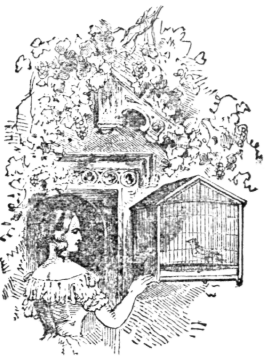The Skylark
Description
This section is from the book "The Corner Cupboard; Or, Facts For Everybody", by Robert Kemp Philp. Also available from Amazon: The Corner Cupboard; or Facts for Everybody.
The Skylark
The Skylark. The common lark, field lark, or laverock, as this bird is variously termed, is one of the best known and most highly-esteemed of our native songsters; its shrill music, so sprightly and joyous, has been listened to with delight by everyone. This little brown bird is one of the plainest, and even meanest, of all the feathered choir - a bird that, though it builds its neat low in the gorses, hath, as Elizabeth Barrett says, "Its song in the stars' courses," to show, as our poet tells us, what " honour hath humility." This is the Alauda arvensis of naturalists; and the largest of our native larks, measuring, commonly, seven inches in length, allowing about three inches for the tail. It is a handsome, sprightly-looking bird, with a silky crest, erectable at pleasure. It looks sadly out of place in a cage, although it is often so kept, for the sake of its shrill, (dear melody, which may be heard rising above the din of the busy street, and suggesting images and scenes of country life. We need not describe the colours and markings of the plumage, for they must be sufficiently familiar to all our readers. The female may be distinguished from the male bird by its smaller size, and more thickly and darkly-spotted breast, which has, too, less of a ferruginous tinge than that of the male.

Black and white varieties of this bird occasionally occur: the plumage of the former is of a motley hue, with a tinge of dull red showing through; the latter is either pure white or yellowish. Specimens of this variety are sometimes found wild. In February or March these flocks break up, and soon after commences' the work of incubation. The nest is generally built in a hole scraped in the ground, or a natural hollow between two ridges in a corn or hay-field. The Scottish poet, Grahame, thus describes it:"On tree or bush no lark is never seen:
The daisied tea he loves, where tufts of grass Luxuriant crown the ridge; there, with bis mate, He founds his lowly house of withered bents, And coarsest speargrass; next the inner work With finer and still finer fibres lays, Rounding it curious with his speckled breast,"
And in this little fabric, which Macgillivray says is rather loosely put together, may be found four or five eggs, of a greenish gray colour, freckled and marked with grayish brown. There are generally two broods in the year, the first young appearing sometimes as early as the end of April; the second come out in June or July. They frequently leave the nest before they are fully Hedged; and, therefore, should be taken for rearing in good time. They should be fed with white bread, soaked in milk, and crushed poppy seed; a few ants' eggs conduce much to make them healthy. The males may be known by the yellow tinge of their plumage In confinement they should have poppy seed, crushed hemp, barley-meal, and bread crumbs, with an occasional supply of green food, such as water-cresses, cabbage, lettuce, etc. A little lean meat, with ants' eggs, now and then, by way of a treat, tend to make them lively, and more inclined to sing. Adult birds, introduced into the aviary, will become immediately reconciled if they have some oats and poppy seed thrown to them; afterwards they will do very well on the universal paste. Any air or melody which it is desired they should learn most be whistled to them before they are fully fledged, as the males commence practising their natural song very early. They must also be kept separate from other birds while under this system of tutelage. Naturalists say that adult larks will sometimes acquire the song of the chaffinch and nightingale. Larks are subject to the ordinary maladies which afflict birds, and are especially liable to yellow scurf about the beak; generous diet, such as ants' eggs, meal worms, with green food, and universal paste, are most likely to cure this. These birds will live eight or ten years in confinement. We have heard of instances of extreme longevity; as many as thirty years being mentioned. They require a cage at least a foot and a half long, nine inches wide, and fifteen inches high; the shape is immaterial, and it is best to cover the top with cloth, as the birds have a habit of springing upwards, especially when they are at all wild, and so may injure themselves. Their food and drinking-vessels should be of glass or porcelain; a piece of fine turf, renewed at least once a week, should be placed in the bottom of the cage; and great attention should be paid to cleanliness, as, if the feet get dirty, they are apt to acquire disease.

Continue to:


